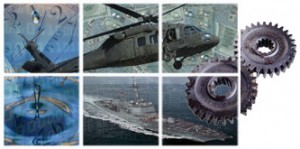KBSI is developing a roadmap for depot information integration and situation based planning, scheduling, and control system support. KBSI is taking a scientific approach, studying the MRO environment, its fundamental nature, the underlying physics of MRO operations and processes-planning, scheduling, execution, control—the issues of dealing with aging workloads, and the processes that perform the repair.
The driving principle at the core of the Sustainment Technologies for Aircraft Depot Maintenance (S-Physics) initiative, now in Phase III, is that planning and scheduling in a depot maintenance, repair, and overhaul (MRO) environment is a unique activity. Manufacturing systems make explicit the need for prior planning: i.e., the coordination of resources prior to the initiation of the work. Manufacturing systems assume that the lead-time to perform the coordination of resources (whether it be an acquisition activity, worker training, etc.) can be described and used in determining the appropriate schedules used by shops and management for setting baselines, tracking work, and setting budgets. In the MRO environment, however, these systems prove inadequate. The information managed by such systems is insufficient, and maintained at the wrong level of granularity does not incorporate knowledge of the true state of repair (with respect to work or resources) as well as provides faulty baselines based on infeasible plans and therefore schedules and provides skewed estimates of the resource requirements necessary to complete a given workload.
Addressing these challenges requires understanding the environment, its fundamental nature, the underlying physics of MRO operations and processes-planning, scheduling, execution, control—the issues of dealing with aging workloads, and the processes that perform the repair. The answer lies in the development of systems based upon a solid, scientifically founded understanding of MRO. The S-Physics project is developing the roadmap and planned evolution for depot information integration and situation based planning, scheduling, and control system support.
Phase II Development
A by-product of the S-Physics guiding principles and practices for aircraft sustainment was a detailed characterization of the fundamental differences between the production manufacturing and the sustainment domains. These differences motivated the need for a closed-loop, high velocity, constraint-based planning and scheduling infrastructure called FastPlan that enables significantly higher levels of asset and status visibility, coordination support, shop floor knowledge capture, and rapid rescheduling capability. FastPlan provides the architectural framework that enables MRO-based planning and scheduling functions, with critical decision support generated through the state of the art simulation component, e-SIM. e-SIM provides rule-centric, discrete event simulation that supports the sustainment principles derived during the S-Physics project.
 e-SIM was developed in response to the fundamental distinguishing MRO environment issue: the underlying work content of an item is unknown prior to repair. The implication of this issue is that all systems that support an MRO process, in which the work content must be planned and scheduled at the point-of-repair, must provide a mechanism for the characterization, modeling, and analysis of that situation in both the process and the information-decision support system software. The e-SIM component allows planners and schedulers to perform point-of-repair resource allocation and opportunistic-scheduling scenario evaluations.
e-SIM was developed in response to the fundamental distinguishing MRO environment issue: the underlying work content of an item is unknown prior to repair. The implication of this issue is that all systems that support an MRO process, in which the work content must be planned and scheduled at the point-of-repair, must provide a mechanism for the characterization, modeling, and analysis of that situation in both the process and the information-decision support system software. The e-SIM component allows planners and schedulers to perform point-of-repair resource allocation and opportunistic-scheduling scenario evaluations.
Perhaps the most significant result of the S-Physics project is a comprehensive understanding of sustainment that has provided the foundation and means for the study of MRO behavior and a rich knowledge base of system and analysis artifacts. This study of MRO behavior elicited the guiding principles for the development of the FastPlan and e-SIM components that have shown great promise in helping the Air Force improve MRO planning and management and in the continuing development of solution systems within MRO environments.
